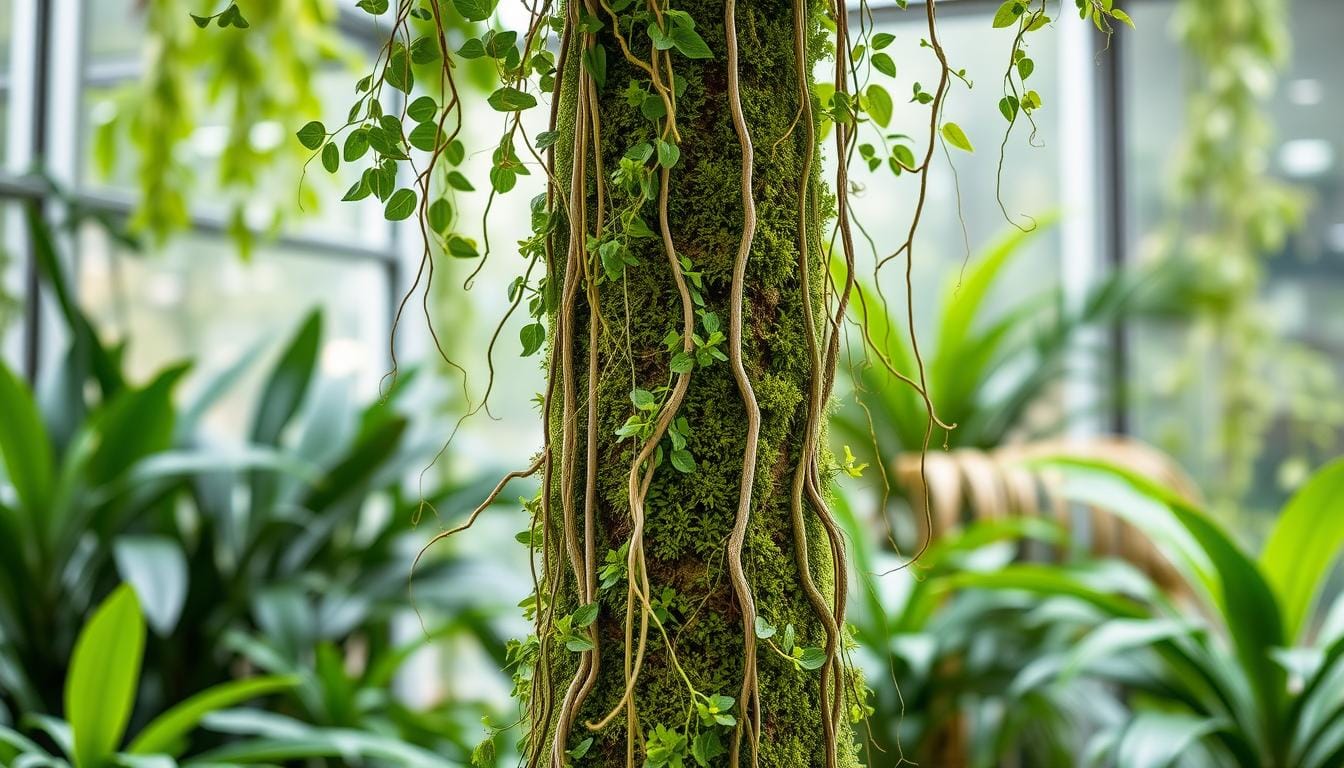DIY Moss Pole for Plants: Support Your Climbing Beauties
If you love indoor plants, you might struggle to find the right support for climbers like Monstera, Pothos, and Philodendron. Moss poles are a great solution. They give structural support and create a humid environment, just like their natural homes. This guide will show you how to make your own moss pole. It will help your climbing plants grow strong and healthy.
Key Takeaways
- Moss poles provide essential support for climbing plants like Monstera, Pothos, and Philodendron.
- DIY moss poles can be crafted using readily available materials, including a sturdy support structure, fabric or mesh, moss, and twine or string.
- Proper placement and maintenance of moss poles are crucial for the health and growth of your indoor plants.
- Moss poles contribute to a humid microclimate, prevent root rot, and promote healthy plant development.
- Moss poles can be incorporated into indoor decor in creative ways, making them both functional and visually appealing.
What is a Moss Pole and Why Use One?
Moss poles help climbing plants grow up, like Monstera, Philodendron, and Pothos. They look like the plants’ natural home, where they climb on trees. The pole’s core is strong, like PVC or bamboo, covered in moss or coir.
Benefits of Using a Moss Pole
Using a moss pole has many benefits for your plants:
- It helps plants grow aerial roots, which stick to the pole and support the plant.
- It keeps moisture in, creating a humid spot that’s good for the plant’s health and leaf growth.
- It makes your plants look better, especially the big-leafed ones.
- It lets plants climb naturally, making them look fuller and more lush.
Popular Plants That Thrive on Moss Poles
Many houseplants love the support of a natural coir pole or moss pole. Here are some favorites:
- Monstera deliciosa (Swiss Cheese Plant)
- Philodendron species
- Pothos (Devil’s Ivy)
- Epipremnum aureum (Golden Pothos)
- Scindapsus pictus (Satin Pothos)
These plants grow bigger, brighter leaves and look amazing when they climb. They add beauty and interest to your indoor plants.
Materials Needed for Your DIY Moss Pole
Making a moss pole for your climbing plants is simple and only needs a few items. You can use it for a Monstera, Swiss Cheese vine, or Golden. Having the right stuff will make your moss pole a hit.
Choosing the Right Type of Moss
First, you need moss for your pole. You can pick between sphagnum moss and sheet moss. Sphagnum moss goes inside for a soft, wet core. Sheet moss wraps around for a green, natural look.
Other Essential Supplies
- Stake material: Bamboo, PVC pipe, wooden dowel, or even bamboo chopsticks make great structural supports.
- String or twine: Use fishing line, jute, or other natural fibers to secure the moss to the stake.
- Scissors or wire cutters: For trimming the moss and cutting the netting or hardware cloth.
- Zip ties or wire: To fasten the moss and secure the pole in place.
- Optional: Garden stake or dowel rod for extra stability and support.
Remember to wear cut-resistant gloves to protect your hands. A hacksaw might be useful if you need to cut a PVC pipe.
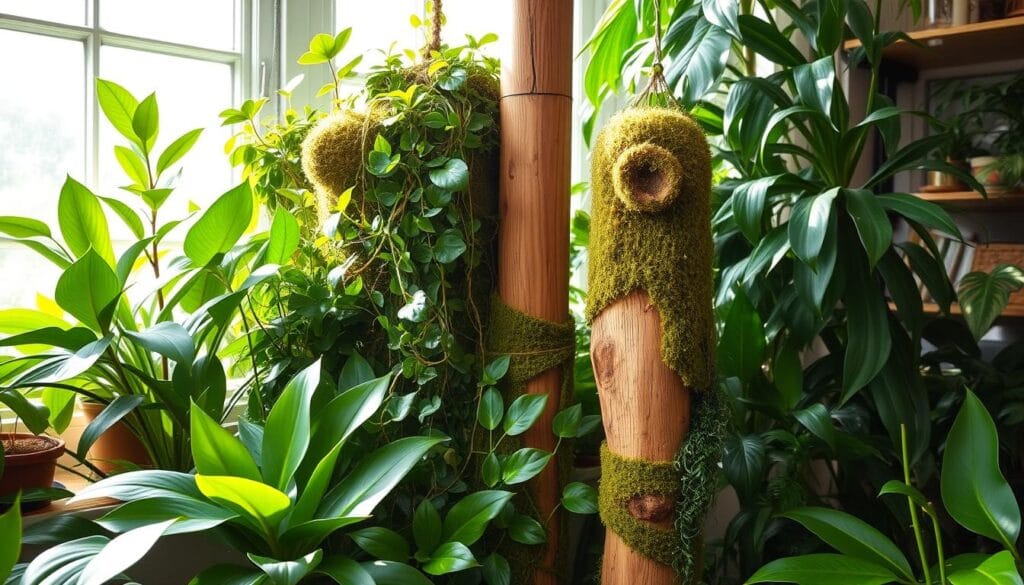
“The key to a successful moss pole is having the right materials on hand to create a sturdy, moisture-retentive structure for your climbing plants.”
With these basic supplies, you’re ready to make a moss pole. It will help your potted plant grow for many years.
Step-by-Step Instructions for Making a Moss Pole
Creating a homemade moss pole can elevate your vining plant’s growth. It’s a plant stake extension that supports and moistens your climbing plants. Let’s explore how to make your own moss pole for a beautiful display at home or in your garden.
Preparing Your Materials
To start, gather these essential items:
- Sphagnum moss (enough to wrap around your desired pole size)
- A wooden dowel or PVC pipe as the core
- Twine or fishing line to secure the moss
First, soak the sphagnum moss in water for 10-15 minutes. This makes it fully saturated and ready to cling to the pole. It also ensures your plants get the moisture they need.
Assembling the Moss Pole
Now, let’s build the moss pole. If using a PVC pipe, wrap the moss around it tightly. For a wooden dowel, create a cylinder with wire mesh and fill it with moss.
Adding the Moss Layer
Wrap the moss around the core, starting from the top. Use twine or fishing line to hold it in place. Make sure the moss is packed tightly for a stable, moist environment for your plants.
“The finished moss pole should be at least 1 to 2 feet taller than the plant it supports, with 6 to 12 inches buried in the soil for stability.”
By following these steps, you’ll create a moss pole that boosts your vining plants’ growth and looks. Watch your climbing beauties flourish with your DIY moss pole!
How to Safely Install a Moss Pole in Your Plant’s Pot
Adding climbing plants to your home can make it feel like a tropical paradise. A moss pole is a great way to support these plants. It’s important to install it safely to help your plants grow well. Here’s how to securely place a moss pole in your plant’s pot.
Finding the Perfect Spot
First, pick a pot that’s deep enough to bury one-third of the moss pole. This gives your plant a strong base to climb from. Place the pole near the plant’s stem so the vines can easily wrap around it.
Securing the Pole in Place
To keep the moss pole steady, you can bury it in the soil or use sticks at the base. This method keeps the pole from moving as your plant grows. After securing the pole, gently move your plant next to it. Make sure the stem is close enough for the vines to reach the pole.
To help your plant climb, use twine or soft ties to attach stems to the moss pole. This will guide the vines upwards and start the climbing process. With the right spot and securing method, your moss pole will support your tropical plant’s growth.
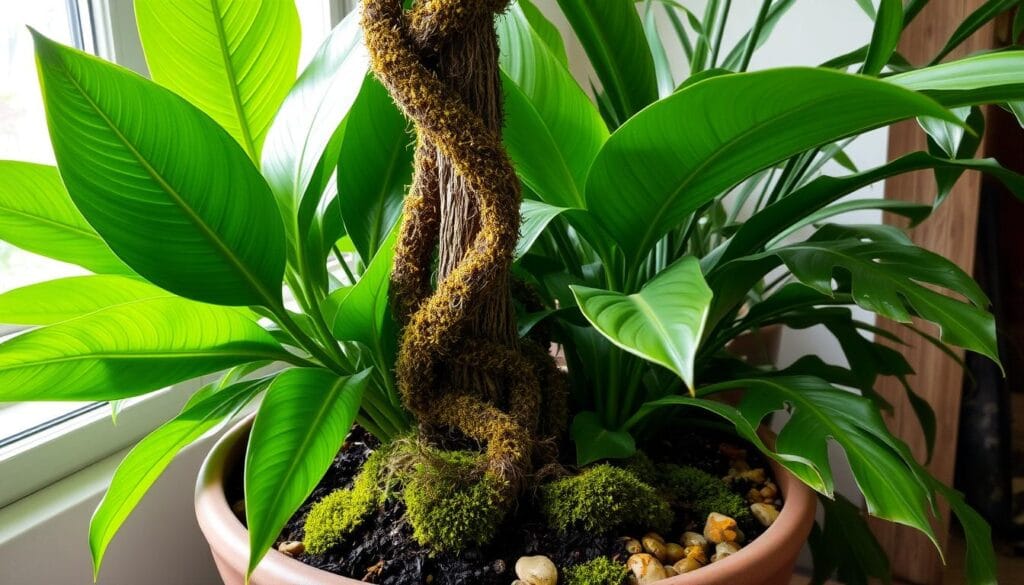
Caring for Your Moss Pole
Keeping your moss pole healthy is key for your climbing plants to grow up. To make sure your moss pole is perfect, follow these important care tips.
Watering and Moisture Requirements
Make sure the moss stays damp by misting it often or pouring water at the top. Don’t overwater, as it can cause root rot. The moss should be a bit wet but not too wet. Check the moisture often and adjust your watering to keep the right humidity for your plants.
Fertilizing for Optimal Plant Growth
- Fertilize your plants based on their needs, using the moss pole to spread nutrients.
- Use a balanced, water-soluble fertilizer. Apply it to the moss or pour it into the pole’s top. This lets the roots absorb the nutrients.
- Good fertilization and the climbing plant support from the moss pole will help your plants grow well. They will have lush, vertical plant growth and bright leaves.
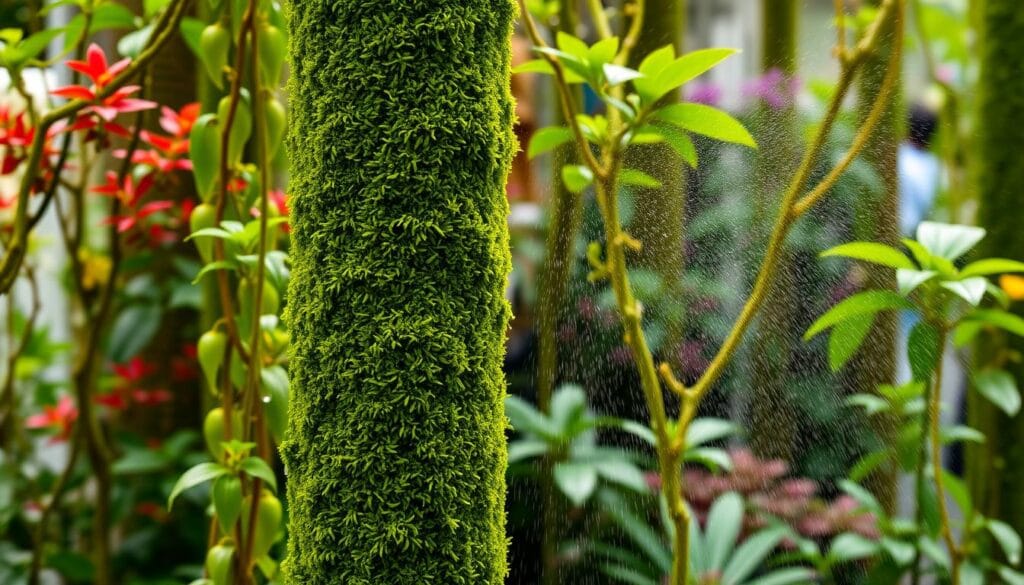
With the right moisture and nutrients, your moss pole will be the best place for your climbing plants to grow and reach high.
Training Your Plants to Climb the Moss Pole
Teaching your vining plants to climb a moss pole is a big step for their growth and look. Start by gently guiding the stems towards the pole with soft ties. This helps them get a good hold and begin climbing. Maintaining high humidity around the pole is key too. It helps the aerial roots grow, which will stick to the moss.
Watch for signs that your plant is climbing well. New growth attaching to the pole and more vertical development mean you’re doing great. With care and patience, your indoor space will become a lush, green oasis.
Techniques for Encouraging Growth
- Gently guide plant stems towards the moss pole using soft, flexible ties
- Maintain high humidity around the pole to promote aerial root development
- Regularly mist the moss to keep it moist and inviting for your plant’s aerial roots
Signs of Successful Climbing
- New growth attaching to the moss pole
- Increased vertical development and height
- A lush, full appearance as the plant cascades down the pole
Learning to train your plant training pole and vining plant guide will help your plants grow. It also makes your indoor space look better. With patience and effort, your plants will flourish and make your home a beautiful plant paradise.
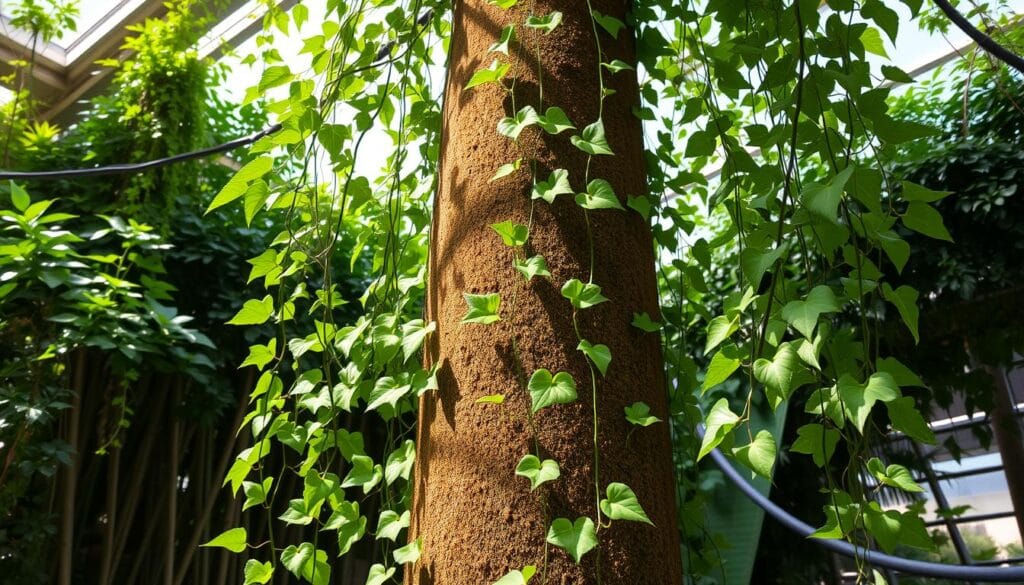
Common Challenges with Moss Poles
Moss poles are great for potted plants, helping them climb naturally. But, they can face some common problems. These need quick attention and care.
Issues with Mold and Algae
Mold and algae can grow on moss poles. This happens because they are damp and full of nutrients. To stop this, make sure air can move around the pole and don’t water too much.
Using hydrogen peroxide or a hose can clean the pole. This keeps it healthy and free from mold and algae.
How to Troubleshoot Sagging Plants
Stable moss poles are key to prevent plants from falling. Check the pole’s stability often, especially for tall plants. If it’s not stable, you might need to make changes or add support.
As plants grow, they might need more support. You can extend the pole or let the plant cascade. This keeps the plant looking good and supported.
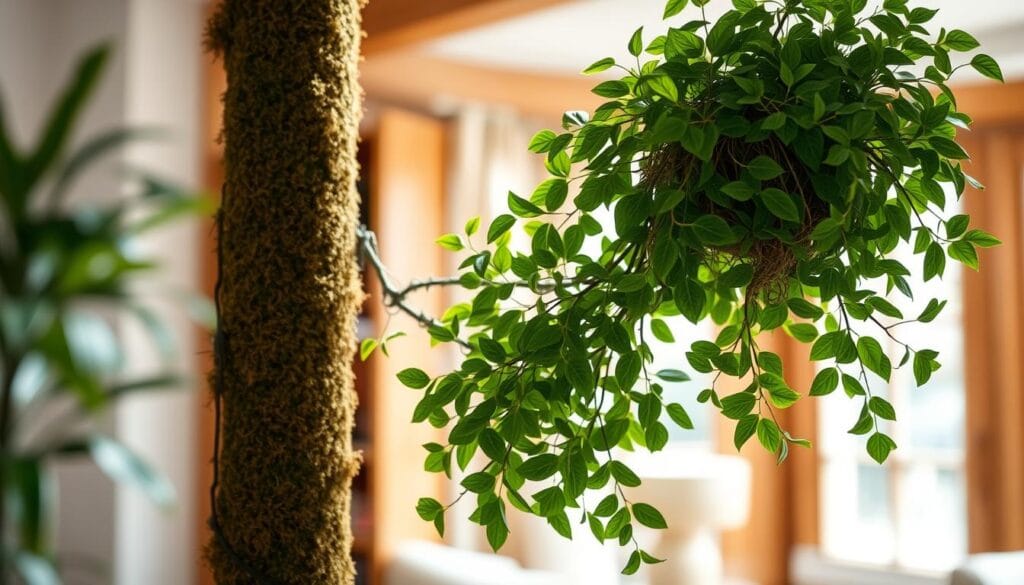
Moss poles are great for climbing plants, but they come with challenges. Problems like mold, algae, and sagging plants need quick fixes. By tackling these issues, your plants will do well and make your space look better.
Alternative Support Structures for Climbing Plants
Moss poles are a favorite for supporting climbing plants, but they’re not the only choice. It’s crucial to pick the right support for your plant’s growth. This depends on the plant’s unique needs and characteristics.
Comparing Moss Poles to Trellises
Trellises give plants more room to climb, which is great for some species. But, they don’t hold moisture as well as moss poles. This makes them less good for plants that love moist environments.
Using Bamboo Stakes vs. Moss Poles
Bamboo stakes are a green alternative to moss poles. They’re strong enough for small plants or those just starting to grow. Though they don’t hold moisture like moss poles, they’re still a good choice for some plants.
When picking a support, think about your plant’s growth, size, and moisture needs. Knowing your plant’s specific needs helps you pick the best support for it to thrive.
| Support Structure | Advantages | Disadvantages |
|---|---|---|
| Moss Poles |
|
|
| Trellises |
|
|
| Bamboo Stakes |
|
|
Looking into other support options for climbing plants can help you find the best fit for your indoor garden. The key is to match the support system with your plant’s growth habits and moisture needs for the best health and look.
Seasonal Considerations for Moss Pole Care
Caring for your indoor tropical plant with a moss pole changes with the seasons. You need to adjust your watering and humidity levels. This keeps your tropical plant care routine effective.
Adjusting Care in Different Weather Conditions
In warmer months, your plants need more water to keep the moss pole moist. In cooler winter months, water them less to avoid root rot. Also, keep them away from cold drafts and check their growth to ensure they’re doing well.
Winterizing Your Moss Pole
For outdoor indoor plant trellis setups, wrap the moss pole in burlap or a protective material. This protects it from harsh winter weather. Or, bring potted plants with moss poles indoors for better growing conditions all year.
| Season | Watering Frequency | Humidity Levels | Placement |
|---|---|---|---|
| Spring/Summer | More frequent | Higher | Bright, indirect light |
| Fall/Winter | Less frequent | Lower | Away from cold drafts |
By paying attention to your tropical plant care needs throughout the year, your moss pole-supported plants will thrive. This makes your indoor oasis more beautiful and air-purifying.
Environmental Impact of Using Natural Materials
The materials you choose for your moss pole matter a lot for the environment. Going for natural coir pole and sphagnum moss is a big step. It makes a huge difference.
Benefits of Sustainable Choices
Coir and moss are biodegradable, which means they don’t harm the environment. They’re better than plastic or metal because they don’t pollute. By picking natural coir pole and moss, you help your plants grow and reduce your carbon footprint.
Giving Back to Nature with Your Plants
Creating an indoor garden with natural coir pole supports helps nature. The greenery and vertical plant growth improve air quality. This creates a mini ecosystem that helps local wildlife.
“By using natural materials, we can create beautiful, functional spaces that are in harmony with the environment.”
Choosing the right materials for moss poles is more than just for your plants. It’s about making a positive impact on the world. Use natural coir pole and sphagnum moss. Watch your garden flourish and help create a greener future.
Inspiration: Beautiful Plants that Flourish on Moss Poles
Adding a touch of tropical beauty to your home is simple. Climbing plants on moss poles can turn any space into a lush oasis. From the iconic Monstera deliciosa to the cascading Epipremnum aureum (pothos), these plants are a sight to behold.
Stunning Climbers to Try
- Monstera deliciosa: This striking plant is a fan favorite, with its large, fenestrated leaves that climb up a sturdy moss pole.
- Philodendron bipinnatifidum: Also known as the “Tree Philodendron,” this lush plant thrives when given the support of a moss pole.
- Epipremnum aureum (pothos): The classic trailing pothos is a versatile choice that can be trained to climb a moss pole, creating a stunning vertical display.
Successful Home Garden Examples
Seeing moss poles in action is truly inspiring. Here are some stunning home gardens that show off climbing plants on moss poles:
“I was amazed at how quickly my Monstera deliciosa grew once I added a moss pole to its pot. It’s now a stunning focal point in my living room!” – Emily, plant enthusiast
Sarah, another home gardener, talks about her moss pole experience: “My Philodendron bipinnatifidum has really taken off since I added a moss pole. The leaves are bigger and more vibrant than ever before.”
Looking to add tropical flair to your indoor space? Moss poles can be a game-changer. Get inspired and start planning your own lush, vertical garden today!
Conclusion: Enhance Your Plant Care Routine
Adding a moss pole to your plant care routine has many benefits. It helps plants grow healthier and taller. It also makes your indoor spaces look more natural and elegant.
Recap of the Benefits of Using a Moss Pole
Sphagnum moss poles keep plants moist, which many plants love. This includes Monsteras, Pothos, and Philodendrons. The moss also gives plants nutrients as water moves through it. This makes plants healthier and more vibrant. Plus, moss poles look great, making your indoor garden even more beautiful.
Encouragement to Get Started on Your DIY Project
Creating your own moss pole is easy with our guide. It’s a fun DIY project that makes your plants grow strong and tall. It’s perfect for both new and experienced plant lovers. Adding a moss pole to your routine brings more green and life to your home.


